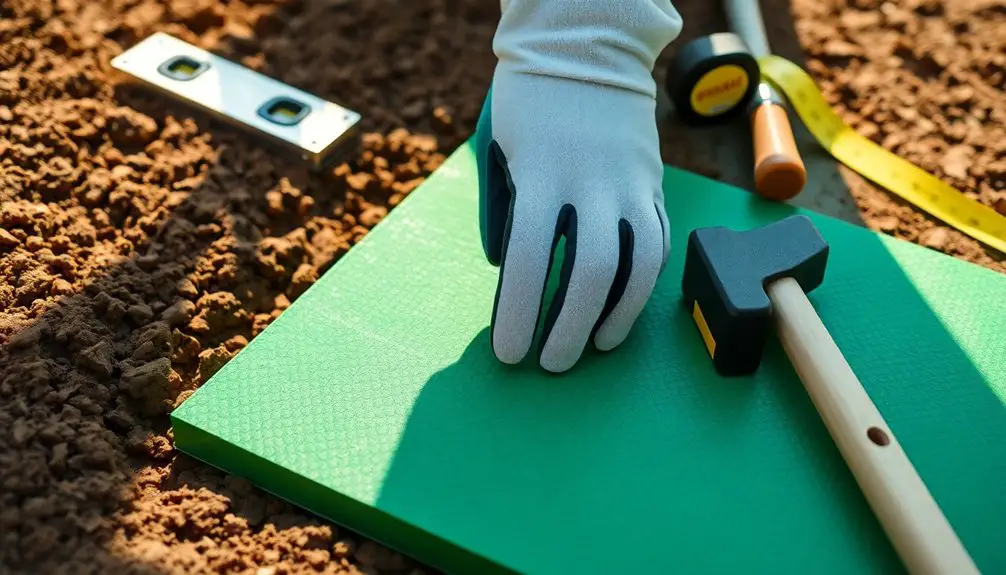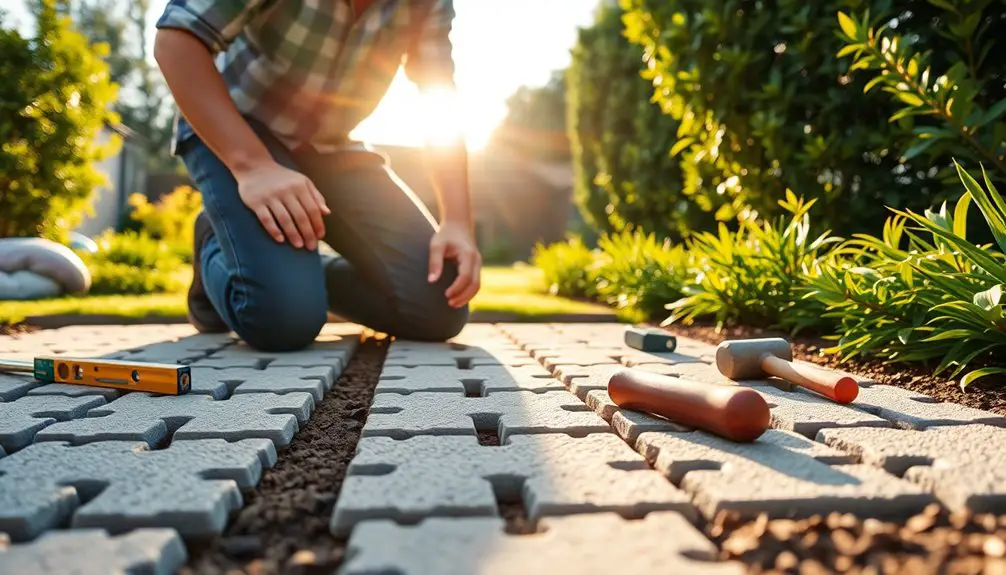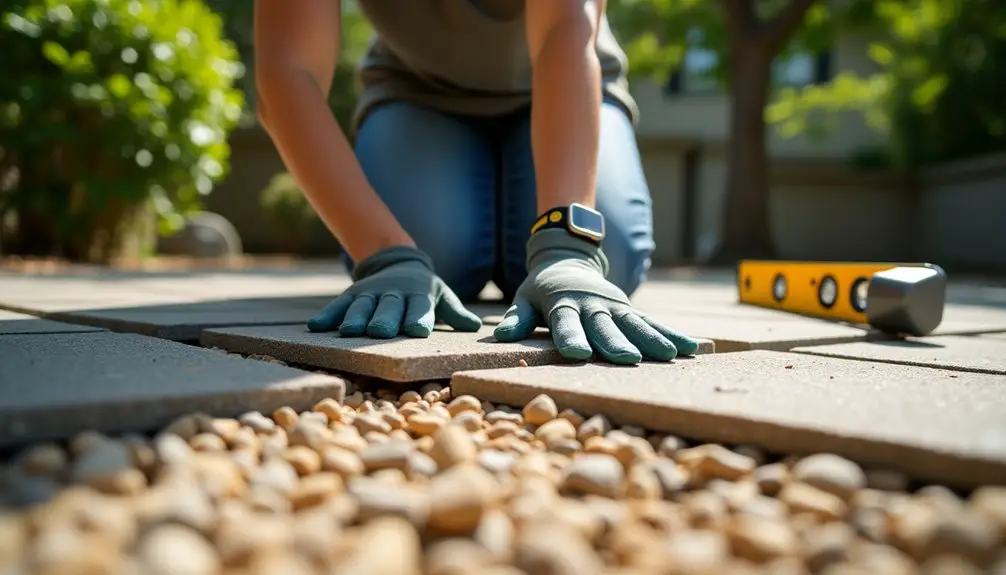Installing polypropylene paver base panels is a simple DIY task that can save you time and costs. Start by removing existing sod and leveling your installation area. Lay the panels over a sand bed, staggering the seams for added stability. Be sure to install durable edging with stainless steel screws to maintain height. Focus on drainage to prevent water pooling, as this is crucial for durability. If your project's over 200 sq. ft., consider hiring a pro to ensure everything's done right. Keep going to discover more tips and tricks to make your installation even smoother!
Key Takeaways
- Begin by removing sod and leveling the installation area for a stable foundation.
- Lay polypropylene paver mats over a leveled sand bed, ensuring seams are staggered for enhanced stability.
- Install durable edging using stainless steel screws to maintain consistent height and prevent shifting.
- Prioritize drainage planning to avoid water pooling and ensure proper water management.
- Consult local building codes to ensure compliance during the installation process.
Overview of Polypropylene Paver Bases
Installing polypropylene paver bases offers a modern solution for outdoor projects. These lightweight, high-density panels streamline your installation process, reducing labor by up to 50% compared to traditional gravel bases.
With their tongue-and-groove or shiplap edges, you'll achieve better alignment and stability, essential for a durable foundation. Plus, the built-in drainage channels ensure effective water management, preventing potential issues down the line.
When you choose polypropylene paver bases, you're opting for a material that performs just as well as compacted gravel for load distribution. This makes them a viable alternative, especially in areas where heavy equipment can't easily access.
While they may be pricier upfront, their installation speed and minimal long-term maintenance costs can save you money over time.
To enhance your project's effectiveness, consider using landscape fabric to reduce weed growth and improve stability. Additionally, an edge restraint will help keep your paver base in place, ensuring a clean, finished look.
Benefits and Drawbacks
When considering polypropylene paver bases, you'll find a mix of significant benefits and notable drawbacks. One of the primary advantages is that these paver bases require 40-50% less digging than traditional gravel options, which can save you substantial labor and excavation effort.
You'll also appreciate how they eliminate the need for heavy gravel fill, lowering your overall costs for digging and hauling materials. The lightweight, high-density polypropylene composition makes for easier handling, especially in restricted access areas.
On the downside, while these bases provide better stability and drainage, they typically come with a higher initial cost compared to gravel.
You'll also need to consider their performance under extreme weather conditions. Polypropylene paver bases may struggle at temperatures below -20°F or above 140°F, increasing the risks of ice formation during winter months.
When installing, always check that your layer of sand is well-prepared to support the panels. Weigh these pros and cons carefully to determine if polypropylene paver bases are the right choice for your project.
Step-by-Step Installation Process

After weighing the benefits and drawbacks of polypropylene paver bases, you're ready to start the installation process. First, ensure you've removed any existing sod and leveled the area where your paver base panels will go.
Lay the paver mat panels over a leveled sand bed, staggering the seams for better stability. This alignment helps create a straight line that enhances the overall appearance of your project.
Next, install durable paver edging using stainless steel screws to maintain a consistent height throughout the area. Ensure the edging aligns perfectly with your paver layout.
Place the pavers directly onto the synthetic base panels, starting with the border pavers, which will define the edges of your design. Once the border is in place, fill in the joints with compatible material for a polished finish.
Throughout the installation, maintain a uniformly compacted base to prevent settling over time.
Don't forget to prioritize drainage planning by incorporating weep holes or slopes to avoid water pooling. Following these steps will ensure a stable and aesthetically pleasing installation of your polypropylene paver base panels.
Professional Help Considerations
Considering the complexity of certain paver installations, it's often wise to enlist professional help. If your project exceeds 200 square feet or involves unique design elements, experts can provide insights that help prevent costly errors. This is especially true for installations needing to make considerations for drainage issues or intricate layouts, like raised patios or poolside areas. Additionally, professional help can ensure that eco-friendly materials, such as recycled polypropylene, are used to minimize environmental impact.
| Consideration | DIY Approach | Professional Help |
|---|---|---|
| Project Size | Manageable under 200 sq. ft. | Recommended for over 200 sq. ft. |
| Access Restrictions | Limited options | Ensures compliance with codes |
| Weather Challenges | May cause delays | Efficiently manages unexpected issues |
| Design Complexity | Simple layouts only | Handles intricate designs |
Engaging professional help also saves you time and effort, allowing you to focus on smaller, manageable tasks. They're commonly used in situations where unexpected challenges may arise, providing peace of mind and ensuring quality results. If you're uncertain about your skills or the project scope, consider consulting a licensed contractor for the best outcome.
Expert Tips and Common Questions

Installing polypropylene paver base panels can be straightforward if you follow some expert tips and address common questions. First, make sure you lay the panels over a leveled sand bed, staggering them to avoid seams. This alignment helps maintain stability and ensures a smooth surface.
Also, place the panels flush with surrounding areas for a clean finish. When securing paver edging, use durable stainless steel screws. This will help us maintain consistent height and alignment throughout your project. Start laying pavers directly onto the synthetic base panels, beginning with the border pavers. Fill the joints with a compatible material to create a solid finish.
Common mistakes to avoid include neglecting proper drainage planning and failing to use edge restraints for paver alignment. It's crucial to allow sufficient time for leveling—this can prevent uneven surfaces.
Lastly, consult local building codes for specific requirements regarding base installation, and ensure that the compacted sand or fine gravel beneath the synthetic bases is between 1-2 inches deep for optimal performance. Remember, keeping the area clear and away from the house can also aid in effective water drainage.
Frequently Asked Questions
What to Put Under Paver Base Panels?
You should start with a leveled sand bed, about 1-2 inches thick, to provide stability. Consider adding landscape fabric underneath to prevent weeds while maintaining drainage. This foundation's crucial for your paver installation's success.
How Deep Do You Dig for Paver Base Panels?
You'll typically dig about 1-2 inches for paver base panels, ensuring stability. Depending on your area's climate, you might need to adjust the depth slightly. Always check local codes for specific recommendations.
Do You Tamp Down a Paver Base?
Yes, you should tamp down a paver base. It creates a solid foundation, prevents settling, and ensures a stable surface. Use even pressure and work in small sections for the best results.
Do Paver Base Panels Really Work?
Yes, paver base panels really work. They provide excellent load distribution and drainage, making your outdoor surfaces stable and durable. You'll find they're lightweight and easy to handle, significantly speeding up your installation process.

